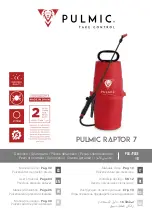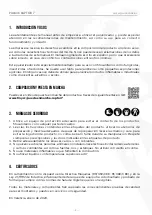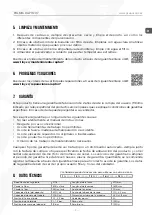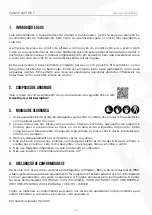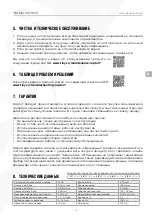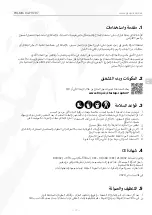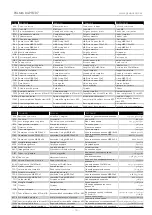
www.gruposanz.es
—
4
—
PULMIC RAPTOR 7
1. INTRODUCTION AND USES
Read this manual carefully before starting to use the sprayer and pay special attention to the
maintenance recommendations, as well as their use for correct operation and useful life.
The company reserves the rights to changes the composition of the product without prior
notice as well as its technical characteristics. No claims can be derived from the data and
illustrations in this manual. The original manual is written in Spanish, so it will prevail over the
rest, in case of conflict or contradictions between other languages.
This sprayer is specially designed for use with phytosanitary products such as fungicides,
insecticides or herbicides. It can be used both for gardening and small farms. In no case should
it be used to spray flammable or industrial products such as solvents, alkalis or acids.
2. COMPOSITION AND START-UP
Watch the product commissioning video through the following link or QR:
www.tiny.cc/startup-raptor7
3. SAFETY RULES
1. Use appropriate protective equipment to avoid contact of plant protection products with
any part of the body.
2. Read the instructions contained in the product labels, use the appropriate preparation and
mixing utensils, after preparation wash your hands and face, to avoid ingesting the product,
do not eat, drink or smoke during handling. Always respect the prescriptions and doses
indicated on the product labels.
3. Properly remove empty or leftover containers.
4. Do not spray on people, animals, or electrical installations. Avoid drifting to neighboring
fields and crops, as well as to sources, rivers and ponds. Do not use against the wind.
5. Do not use flammable or combustion-promoting materials.
6. Do not use liquids with temperatures higher than 40°.
4. CE DECLARATION OF CONFORMITY
In compliance with the provisions of the Machinery Directive (2006/42 / CEE) and industry law
21/1992, the manufacturer declares that this equipment has been designed and tested in such a
way that it complies with the Health and Hygiene regulations that apply to it. are enforceable.
Harmonized technical standards ISO 19932-1: 2013; ISO 4254-6: 2009; ISO 16119-1: 2013; UNE
68095-2: 1997; UNE-EN 61960: 2004; 2006/66 / CEE; 93 / 44EEC.
All materials and components have passed the corresponding quality tests to be assembled
and put into service safely.
In Valencia, January 2020.

